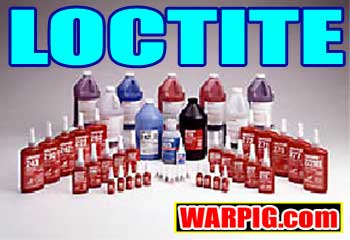  |
|
|
|
|
|
|
  |
|
|
|
|
|
|

About the Author:
What
do you think?
|

Loctite - Friend or Foe? by Kevin "Six" Polk Photos courtesy the Henkel Loctite Corp. It is an accepted fact that if you work on paintball markers, even your own marker, eventually you will find a use for a thread-locker. By far the most popular thread-locker in use today is Loctite®, made by the Henkel Loctite corporation, and will be the focus of this article. Loctite® is a brand name for a family of adhesive products that include thread-lockers and other adhesive products. Thread-lockers are compounds that prevent nuts and bolts from becoming unscrewed, either intentionally or through normal use. They do this by filling in the small spaces between the nut and bolt threads, thereby increasing the contact area to 100%, as we will learn later. This increase in surface area contact increases the friction thereby increasing the force required to remove the nut or bolt. Thread-lockers come in a variety of products designed for a wide range of applications; including permanent, removable, and even thread-lockers that work with plastic products. Unfortunately, most Loctite® users are not aware of the proper procedures, which is what we will cover in this article. Before we talk about how to use Loctite®, first lets discuss several characteristics of Loctite®. For our purposes, we’ll discuss several products from the Loctite® family of products commonly used by Airsmiths. Loctite produces a large variety of thread-lockers, in a variety of colors. An Airsmith used to be able to tell someone to use blue or red Loctite® and they would use the proper type. Considering the tremendous variety of Loctite® today, blue or red Loctite® could now mean several different types. Among the most popular types used by Airsmiths today are 242 (removable strength), 271 (permanent strength), and a new product 243 (somewhere in between). Many people ask why Loctite® is so expensive. According to Loctite®, the primary reason is the bottling method. As we will learn later in this article, air has a lot to do with the curing process. The bottles used to store Loctite® have the ability to allow air to move through the bottle. Before talking about how Loctite® works, first let’s understand the difference between the curing process and drying. When Loctite® dries out, it does not achieve the same effect as when it properly cures. The curing process requires two elements: metal ions and a lack of oxygen (anaerobic environment). Simply put, when you place Loctite® on a metal bolt and screw it in, you are providing metal ions from the metal, and depriving it of air (oxygen), both elements necessary for the curing process. This curing (instead of drying) is essential to how Loctite® creates the bond between the threads that gives us the thread-locking effect.
This is where Loctite®
comes in. As seen in Image 4, Loctite® fills
in the small space and, once cured, provides 100% contact with the thread
surface area. This increased contact area dramatically increases
the force required to remove the bolt. According to Loctite®
engineers, Loctite® currently makes 4 products
that are applicable to the Airsmith community: Loctite®
products 242 (Removable Strength), a relatively new product 243 (Removable
Strength), 271 (Permanent Strength), and 290 (Removable Strength, Wicking
Grade). Although Loctite® does make a pre-applied
product, it is considered an OEM product.
Finally, a Loctite® coated nut or bolt does not have to be torqued hard to achieve the thread-locking effect. Loctite® can begin to cure within a couple of hours, but depending on temperature and humidity, can take up to 24 hours to fully cure and achieve maximum bond. Personal experience has shown that it is important to shake the bottle prior to use. If the bottle sits for a period of time, the ingredients can settle to the bottom, and unless the bottle is shaken prior to use, it can result in an improper bond. One more use of Loctite® is that it can be used in place of Teflon® tape. Since Loctite® seals the spaces between threads, it also seals air and CO2 pressure as well, and serves to provide an air-tight seal on pressure hose fittings. If this is done, any adjustment can break the seal. It is therefore important to remove, clean, and reinstall the Loctite® per manufacturers guidelines to keep the seal. Loctite® can also help repair the seal with damaged threads, a feat Teflon® tape cannot do. Finally, when using Loctite® to seal threads, it’s appearance is much cleaner than having white Teflon tape showing; important on many of today’s high dollar flashy markers. In short, Loctite® use is not just grabbing a bottle and covering the threads. All areas of application; proper cleaning, application, and installation are important. The new Loctite® 243 and Loctite® 290 products continue to gain popularity in paintball and Airsmithing, and serve to give Airsmiths a growing arsenal to choose the exact tool for the job. Loctite is a registered trademark of the Henkel Loctite
Corporation
|
| Copyright © 1992-2019
Corinthian Media Services. WARPIG's webmasters can be reached through our feedback form. All articles and images are copyrighted and may not be redistributed without the written permission of their original creators and Corinthian Media Services. The WARPIG paintball page is a collection of information and pointers to sources from around the internet and other locations. As such, Corinthian Media Services makes no claims to the trustworthiness or reliability of said information. The information contained in, and referenced by WARPIG, should not be used as a substitute for safety information from trained professionals in the paintball industry. |